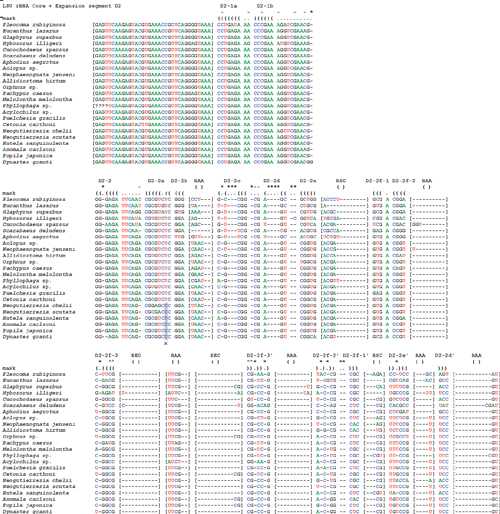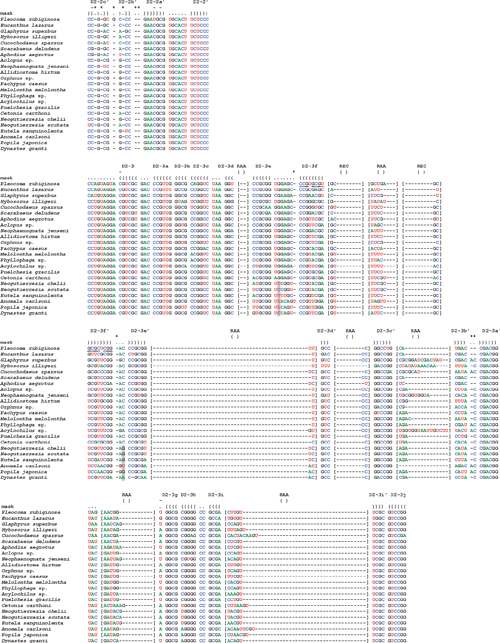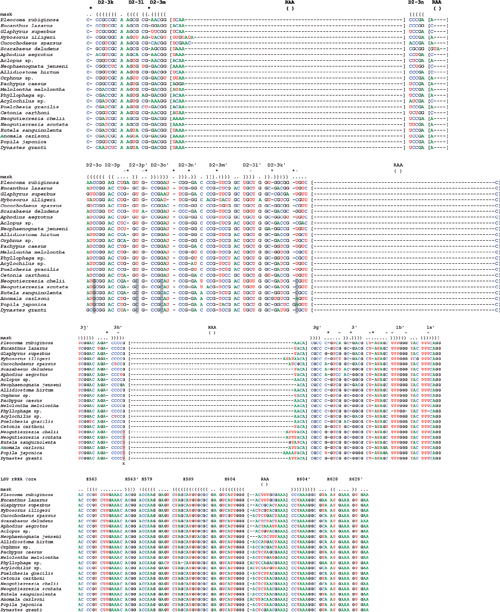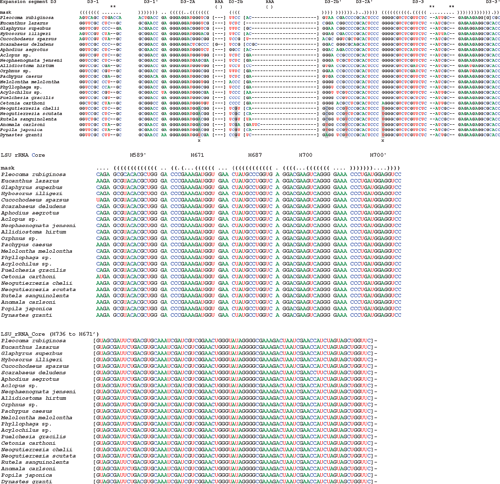Systematic revision, cladistics and biogeography of the genus Neogutierrezia Martínez (Coleoptera : Scarabaeidae) and its phylogenetic placement in Rutelinae based on structural alignment of 28S rDNA sequences
Federico C. Ocampo A B , Eider Ruiz-Manzanos A and Adriana E. Marvaldi AA Instituto de Investigaciones de las Zonas Áridas, CCT-CONICET Mendoza CC 507, Mendoza 5500, Argentina.
B Corresponding author. Email: focampo@mendoza-conicet.gov.ar
Invertebrate Systematics 24(1) 81-111 https://doi.org/10.1071/IS09035
Submitted: 1 August 2009 Accepted: 5 March 2010 Published: 17 May 2010
Abstract
The Argentinean endemic genus Neogutierrezia Martínez, 1953 (Scarabaeidae : Rutelinae) is revised and seven new species are described: N. bicolor Ocampo & Ruiz-Manzanos, sp. nov., N. chelii Ocampo & Ruiz-Manzanos, sp. nov., N. galileoi Ocampo & Ruiz-Manzanos, sp. nov., N. lagosae Ocampo & Ruiz-Manzanos, sp. nov., N. payuniensis Ocampo & Ruiz-Manzanos, sp. nov., N. scutata Ocampo & Ruiz-Manzanos, sp. nov. and N. variabilis Ocampo & Ruiz-Manzanos, sp. nov. Species status is proposed for N. affinis Martínez stat. nov., which was formerly considered as subspecies of N. mirabilis Martínez. The genus Neogutierrezia now includes 10 species distributed in the Monte biogeographic province in Argentina. In order to clarify the systematic placement of the genus Neogutierrezia, a molecular phylogenetic analysis was performed using structurally aligned 28S rDNA sequences (expansion segments D2 and D3) from 23 taxa in Scarabaeoidea, including two representative species of Neogutierrezia. This is the first report of an annotated secondary structure alignment of the D2 and D3 segments of 28S rRNA that spans a wide sample of scarabaeoids, providing a useful homology template for further phylogenetic reconstruction in these and closely related beetles. Results of the molecular parsimony analysis strongly indicate that the genus is closely related to members of the Rutelinae (Scarabaeidae), and thus Neogutierrezia Martínez is transferred from Melolonthinae: Pachydemini to Rutelinae, new placement. A morphological cladistic analysis of the genus was also undertaken, including all the 10 known species in the genus plus two outgroup taxa in Rutelinae, and based on 53 adult characters. The most-parsimonious cladogram provides evidence for the monophyly of the genus, which shows three main clades, distributed in Central Monte and Southern Monte. The adult morphology of the 10 species is described and a key is provided, along with illustrations of the diagnostic characters. The biogeography of species in the genus is discussed.
Acknowledgements
To all the curators and collection managers of the institutions listed in the material and methods section, and to Gastón Zurbarán for making material available for this research, we thank you very much! We thank Mary Liz Jameson for her critical review of the manuscript and most valuable comments. We also thank Aura Paucar (Bio-graphica International LLC) for her help and assistance with some of the line drawings that illustrate this work and Valeria Corbalán (IADIZA) for providing the base map for the species distribution. Federico Ocampo thanks David Hawks and John Heraty (University of California, Riverside) for the generous use of their molecular systematics laboratory and other resources and David Hawks for letting us to use some of the DNA sequences used in this work. This project was supported by NSF (The National Science Foundation, USA) through the following grants: PEET # 0118669, Biodiversity Surveys and Inventories # 0342189, DBI # 0500767, Advances in Biological Informatics # 0743783, and AToL # EF-0531768, and by CONICET (Consejo Nacional de Investigaciones Científicas y Técnicas, Argentina) through the following grants: PIP # 5766, PIP #112-200801-01869, and PIP # 112-200801-00162. The senior author thanks the University of Nebraska State Museum for providing funding to conduct field research in Argentina in 2005 and 2006. We all thank CONICET (Argentina) for its permanent support to our research. Federico Ocampo thanks the Instituto de Ciencias Básicas, Universidad de Cuyo for its ongoing support to his research.
Browne D. J., Scholtz C. H.
(1998) The evolution of the scarab hind wing articulation and wing base: a contribution towards the phylogeny of the Scarabaeidae (Scarabaeoidea: Coleoptera). Systematic Entomology 23, 307–326.
| Crossref | GoogleScholarGoogle Scholar |
[Verified 6 April 2010].
Gillespie J. J.
(2004) Characterizing regions of ambiguous alignment caused by the expansion and contraction of hairpin-stem loops in ribosomal RNA molecules. Molecular Phylogenetics and Evolution 33, 936–943.
| Crossref | GoogleScholarGoogle Scholar |
CAS |
PubMed |
[Verified 6 April 2010].
Graham C. H.,
Ron S. R.,
Santos J. C.,
Schneider C. J., Moritz C.
(2004) Integrating phylogenetics and environmental niche models to explore speciation mechanisms in dendrobatid frogs. Evolution 58, 1781–1793.
| PubMed |
[Verified 6 April 2010].
Martínez A.
(1953) Dos géneros nuevos de Melolonthinae. Boletín de la Sociedad Entomológica Argentina 3, 2.

Martínez A.
(1958) Notas coleopterológicas VIII. Anales de la Sociedad Científica Argentina 166, 100–109.

Martínez A.
(1973) El genero Neogutierrezia Martínez, 1953 (Pachydemini). Anales de la Sociedad Científica Argentina 195, 25–41.

Martínez A.
(1975) Contribución al conocimiento de los Pachydemini neotropicales (Col. Scarabaeidae, Melolonthinae). Entomologische Arbeiten Aus Dem Museum G. Frey 26, 227–251.

Marvaldi A. E.,
Duckett C. N.,
Kjer K., Gillespie J.
(2009) Structural alignment of 18S and 28S rDNA sequences provides insights into phylogeny of Phytophaga (Coleoptera : Curculionoidea and Chrysomeloidea). Zoologica Scripta 38, 63–77.
| Crossref | GoogleScholarGoogle Scholar |

Morrone J. J.
(1999) Presentación preliminar de un nuevo esquema biogeográfico de América del Sur. Biogeográfica 75, 1–16.

Morrone J. J.
(2001) A proposal concerning formal definitions of the Neotropical and Andean regions. Biogeographica 77, 65–82.

Morrone J. J.
(2006) Biogeographical areas and transition zones of Latin America and the Caribbean Islands based on pangeographic and cladistic analyses of the entomofauna. Annual Review of Entomology 51, 467–494.
| Crossref | GoogleScholarGoogle Scholar |
CAS |
PubMed |

Ocampo F. C.
(2004) Food relocation behavior and synopsis of the southern South American genus Glyphoderus Westwood (Scarabaeidae : Scarabaeinae : Eucraniini). Coleopterists Bulletin 58, 295–305.
| Crossref | GoogleScholarGoogle Scholar |

Ocampo F. C., Hawks D. C.
(2006a) Phylogenetic analysis of the scarab family Hybosoridae and monographic revision of the New World subfamily Anaidinae (Coleoptera : Scarabaeoidea). 2. Molecular phylogenetics and systematic placement of the family Hybosoridae (Coleoptera : Scarabaeoidea). Bulletin of the University of Nebraska State Museum 19, 7–12.

Ocampo F. C., Hawks D. C.
(2006b) Molecular phylogenetics and evolution of the food relocation behavior of the dung beetle tribe Eucraniini (Coleoptera : Scarabaidae : Scarabaeinae). Invertebrate Systematics 20, 557–570.
| Crossref | GoogleScholarGoogle Scholar |
CAS |

Ocampo F. C., Ruiz-Manzanos E.
(2007) A revision of the Neotropical genus Anahi Martínez (Coleoptera : Scarabaeidae : Melolonthinae : Pachydemini) with the description of two new species. Neotropical Entomology 36(5), 729–736.
| Crossref | GoogleScholarGoogle Scholar | PubMed |

Ocampo F. C., Smith A. B. T.
(2006)
Puelchesia gracilis, a new genus and species of Pachydemini endemic to the Monte in Argentina (Coleoptera : Scarabaeidae : Melolonthinae). Zootaxa 1349, 53–62.

Phillips S. J.,
Anderson R. P., Schapire R. E.
(2006) Maximum entropy modeling of species geographic distributions. Ecological Modelling 190, 231–259.
| Crossref | GoogleScholarGoogle Scholar |

Robertson J. A.,
McHugh J. V., Whiting M. F.
(2004) A molecular phylogenetic analysis of the Pleasing Fungus Beetles (Coleoptera : Erotylidae): evolution of color patterns, gregariousness and mycophagy. Systematic Entomology 29, 173–187.
| Crossref | GoogleScholarGoogle Scholar |

Roig F. A.,
Roig-Juñent S., Corbalán V.
(2009) Biogeography of the Monte desert. Journal of Arid Environments 73, 164–172.
| Crossref | GoogleScholarGoogle Scholar |

Roig-Juñent S.,
Flores G.,
Claver S.,
Debandi G., Marvaldi A.
(2001) Monte Desert (Argentina): insect biodiversity and natural areas. Journal of Arid Environments 47, 77–94.
| Crossref | GoogleScholarGoogle Scholar |

Sanmartín I.
(2003) Evolución biogeográfica de los Pachydeminae Paleáticos (Coleoptera, Scarabaeoidea) mediante análisis de dispersión-vicarianza. Graellsia 59, 427–441.

Sanmartín I., Martín-Piera F.
(2003) First phylogenetic analysis of the subfamily Pachydeminae (Coleoptera, Scarabaeoidea, Melolonthidae): the Paleartic Pachydeminae. Journal of Zoological Systematics and Evolutionary Research 41, 2–46.
| Crossref | GoogleScholarGoogle Scholar |

Smith A. B. T.,
Hawks D. C., Heraty J. M.
(2006) An overview of the classification and evolution of the major scarab beetle clades (Coleoptera : Scarabaeoidea) based on preliminary molecular analyses. Coleopterists Bulletin 60(5), 35–46.
| Crossref | GoogleScholarGoogle Scholar |


|

|

|

|

|


